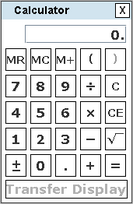
I want to give you a few more GRE quant power tips. There are 8.
(8 also happens to be my favorite number. I like that it is so symmetric. I like that when I push it over, it is the infinity sign or a pair of glasses or the two wheels of my bike).
Anyways…
Power Tip 1: Always, always start with arithmetic
There is no exception to this rule. Arithmetic is the foundation to the quantitative section, and by far represents the largest portion of the exam. Even if you get all the homework questions right, don’t get cocky about arithmetic. It is one of those things that can look deceptively easy, but in reality, is very hard.
if you have doubts as to whether arithmetic can be hard, let me ask you a few questions. Is zero positive or negative? Is one a prime number? Are negative numbers prime numbers? What is the difference between least common denominator and greatest common multiple? What is the divisibility rule for 3? What is the units digit of 1798943^123? The last one is actually a GRE question...and obviously requires you to see patterns and to know foundational math. Hence, I want to emphasize that many GRE quant problems bank on you having studied the complicated stuff but overlooked the "simpler stuff" – hence, arithmetic can be deceptively hard.
Power Tip 2: Know when to use your BRAIN, and when to use your calculator
The onscreen calculator both easy to use and necessarily a little limited in its functionality. You will have to use your mouse to click, which can get tedious.

This is the on-screen calculator. No more. No less.
Try to simplify fractions or round before you reach for the calculator. Our primal instinct is the latter, but actually, you will find that paper and pencil can go much faster.
- For example: with some thinking, fractions like 45/90 become ½ without using the calculator.
- Another example: A $6.25 shirt price can be rounded down to 6 and then that is a nice easy whole number to work with.
Also have you ever wondered what those weird MR, MC, keys on the calculator meant? Here’s what they mean.
- M+ stores numbers in memory.
- MR is recall memory.
- MC is clear memory.
Using them can help you save a little time, but don’t feel the need to. Most people don’t.
Power Tip 3: The power of estimation
This power tip goes along with tip 2. It is in the use-your-brain department. Your motto from now on will be: think before you calculate.
I will show you this tip through example:

This problem looks scary no? Now, DO NOT solve this cold. DO NOT reach for the calculator. It will be more time consuming. Look at the answers and notice that they are all easy whole numbers, which means that there has to be an easier way to solve this problem. What you should do is round all the numbers in the question to the nearest whole number. See below.

The answer is 1! How straightforward was that?! Oh, the power of estimation.
Power Tip 4: Know when to plug in numbers
For some people, plugging in numbers is the last resort. But for certain problems, this is the best first resort. When appropriate, plugging in can be a great method (magic, even), and can save you lots of time.
Consider this question:
Lionel is younger than Maria.
Quantity A Quantity B
Twice Lionel's age Maria's age
(A) Quantity A is greater.
(B) Quantity B is greater.
(C) The two quantities are equal.
(D) The relationship cannot be determined from the information given.
Before you start writing x’s and y’s, let’s try the plug in method.
- If L is 6 and M is 10, then A is greater.
- If L is 4 and M is 10, then B is greater.
And that’s it, the answer is D, because both A or B could be greater.
Power Tip 5: Know your strengths and weaknesses
I have emphasized this many times and for good reason. A very common question I get is: how do I approach a complicated math problem? Unfortunately, there are really no methods or “tricks” that can make up for not knowing a math property. In other words, in numeric entry problems, you don’t even have the opportunity to guess! So my advice to you is this: if you find a question you know you can’t guess, (i.e. it is probability and you just don’t feel comfortable with probability), then skip it. Come back to it later, or use your time to solve problems you do know how to solve.
Power Tip 6: Don’t get flustered if you don’t know the answer immediately.
Even the best math people need thirty seconds to orient themselves to the problem. No one looks at a question and just knows. There is no such thing as knowledge at first sight. To get rid of the butterflies, or at least quell them, pick up that pencil and start writing something. I recommend writing information from the problem. If it is a word problem, try to translate each sentence into an algebraic expression. If it is a numbers only problem, try to write down what you know –– X=integer, Y=positive, etc. Writing helps the wheels start turning.
Power Tip 7: Eliminate careless errors
These are errors that you can avoid! There is no point in learning high level geometry when you miss questions like 2x=10. You will find that if you eliminated all careless errors, you might actually have your goal score without having to learn combinatorics so well.
Power Tip 8: Give yourself a benchmark ‘question’ goal
Instead of telling yourself that you will get X score, tell yourself that you will get 10 right, or 15 right. A whole score is somewhat abstract, a question benchmark is more tangible.
OKAY, break time! Go fuel up. Eat a cookie. You have earned it.

Comments